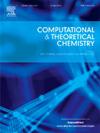金属掺杂B36N36纳米笼对β-lapachone递送的治疗潜力:密度泛函理论研究
IF 3
3区 化学
Q3 CHEMISTRY, PHYSICAL
引用次数: 0
摘要
天然产品长期以来一直是抗癌线索的宝贵来源。β-拉帕酮(β-Lap)是一种天然萘醌类化合物,虽然其低溶解度和生物利用度限制了其在临床的直接应用,但已被证明是一种有前景的抗癌候选药物。氮化硼纳米笼由于其高稳定性和生物相容性而成为潜在的药物递送纳米载体。本文采用密度泛函理论(DFT)评价了过渡金属(M = Fe, Co, Ni, Cu, Zn)掺杂纳米笼B36N36作为β-Lap药物载体的潜力。我们的研究结果表明,β-Lap通过其CO基团与纳米笼的BN键相互作用。金属的掺入有效提高了B36N36的β-Lap吸附特性。在B36N36内部包覆金属是最稳定的结构,在水态和真空状态下,β-Lap在金属包覆B36N36上的吸附能(Zn除外)均高于B36N36。电子密度差(EDD)、自旋密度和前沿分子轨道理论表明,电子从金属掺杂物转移到β-Lap的CO基团,削弱CO键,增强CC键以稳定配合物,金属掺杂显著提高了吸附效率。分子中原子(AIM)理论进一步揭示了金属掺杂将β-Lap与B36N36之间形成的OB键强化为更强的配位键。基于Hirschfeld划分(IGMH)分析的独立梯度模型直观地确定了系统内相互作用区域的空间分布。总体而言,Zn-(1)和Fe-(3)掺杂的B36N36有望成为递送β-Lap的有希望的候选材料,在体温下的恢复时间分别为26.44 s和248 s。这项工作为进一步开发金属掺杂B36N36纳米笼作为药物递送系统提供了硅支持。本文章由计算机程序翻译,如有差异,请以英文原文为准。

Theranostic potential of metal-doped B36N36 nanocages for β-lapachone delivery: A density functional theory study
Natural products have long been a valuable source of anticancer leads. β-lapachone (β-Lap), a natural naphthoquinone compound, has been shown to be a promising anticancer candidate, although its low solubility and bioavailability limit its direct application in the clinic. Boron nitride nanocages have emerged as potential nanocarriers for drug delivery due to their high stability and biocompatibility. Here, we employed density functional theory (DFT) to evaluate the potential of transition metal (M = Fe, Co, Ni, Cu, Zn)-doped nanocage B36N36 as a drug carrier for β-Lap delivery. Our results indicated that β-Lap interacts with the B![]() N bonds of the nanocage through its C
N bonds of the nanocage through its C![]() O group(s). The incorporation of metals effectively enhances the β-Lap adsorption characteristics of B36N36. The encapsulation of metals inside B36N36 was found to be the most stable structure, and the adsorption energy of β-Lap on metal-encapsulated B36N36 (except for Zn) was found to be higher than that on B36N36 in both aqueous and vacuum states. The electron density difference (EDD), spin density, and frontier molecular orbital theory demonstrate electron transfer from metal dopants to C
O group(s). The incorporation of metals effectively enhances the β-Lap adsorption characteristics of B36N36. The encapsulation of metals inside B36N36 was found to be the most stable structure, and the adsorption energy of β-Lap on metal-encapsulated B36N36 (except for Zn) was found to be higher than that on B36N36 in both aqueous and vacuum states. The electron density difference (EDD), spin density, and frontier molecular orbital theory demonstrate electron transfer from metal dopants to C![]() O groups of β-Lap, weakening C
O groups of β-Lap, weakening C![]() O bonds while strengthening C
O bonds while strengthening C![]() C bonds to stabilize the complex, with metal doping significantly enhancing adsorption efficiency. Atoms-in-molecules (AIM) theory further reveals that metal doping reinforces O
C bonds to stabilize the complex, with metal doping significantly enhancing adsorption efficiency. Atoms-in-molecules (AIM) theory further reveals that metal doping reinforces O![]() B bonds formed between β-Lap and B36N36 into stronger coordination bonds. The independent gradient model based on Hirschfeld division (IGMH) analysis visually confirms the spatial distribution of interaction regions within the system. Overall, Zn-(1) and Fe-(3) doped B36N36 are expected to be promising candidates for delivering β-Lap, with recovery times at body temperature of 26.44 s and 248 s, respectively. This work provides in silico support for further development of metal-doped B36N36 nanocage as a drug delivery system.
B bonds formed between β-Lap and B36N36 into stronger coordination bonds. The independent gradient model based on Hirschfeld division (IGMH) analysis visually confirms the spatial distribution of interaction regions within the system. Overall, Zn-(1) and Fe-(3) doped B36N36 are expected to be promising candidates for delivering β-Lap, with recovery times at body temperature of 26.44 s and 248 s, respectively. This work provides in silico support for further development of metal-doped B36N36 nanocage as a drug delivery system.
求助全文
通过发布文献求助,成功后即可免费获取论文全文。
去求助
来源期刊

Computational and Theoretical Chemistry
CHEMISTRY, PHYSICAL-
CiteScore
4.20
自引率
10.70%
发文量
331
审稿时长
31 days
期刊介绍:
Computational and Theoretical Chemistry publishes high quality, original reports of significance in computational and theoretical chemistry including those that deal with problems of structure, properties, energetics, weak interactions, reaction mechanisms, catalysis, and reaction rates involving atoms, molecules, clusters, surfaces, and bulk matter.
 求助内容:
求助内容: 应助结果提醒方式:
应助结果提醒方式:


